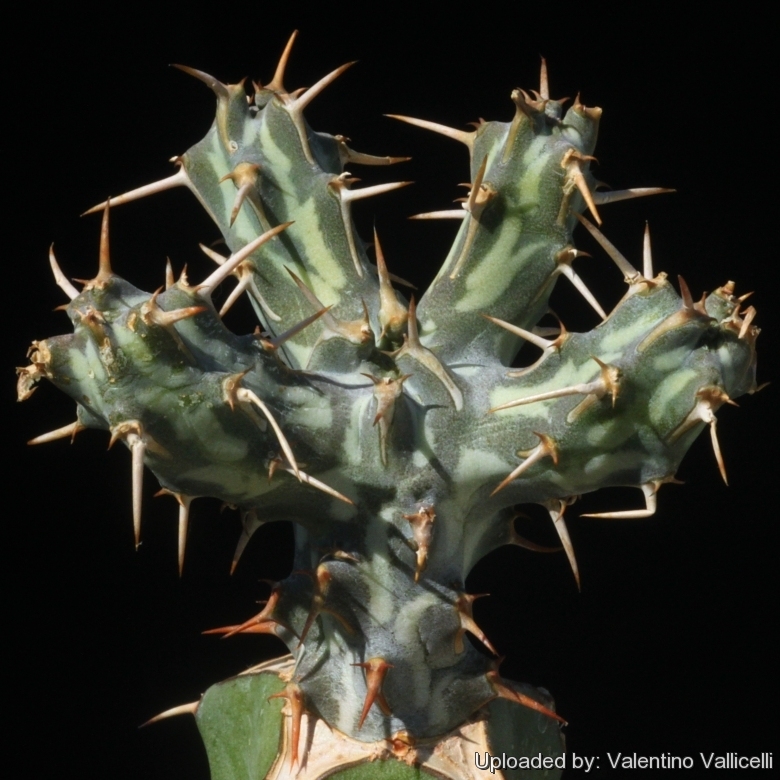
Euphorbia erigavensis Photo by: Valentino Vallicelli
Origin and Habitat: Restricted in distribution to an area around Erigavo, Sanaag region, Somalia.
Altitude range: 1400–1800 m.
Habitat: Grows on rocky limestone plains in open areas scatter with xerophytic Acacia shubs
Synonyms:
Description: It is a spiny perennial succulent that forms small shrubs up to 30 cm tall from a thick very low trunk.
Stem: Main stem very short partly underground, with apex almost at ground level; Lateral branches few, strong, erect to 30 cm long, rebranched only when mature, 1.5-2.5 cm thick, pale greyish-green, blue-green or light-green with reddish brown markings, somewhat toothed, tessellated, with teeth about 1 cm apart in 5-7 spiral series.
Spine-shields: Oblong-triangular about 9 mm long and 5 mm wide.
Main spine: Single, 1.5–3 cm long and stout.
Stipular spines: 1–3 mm long.
Inflorescence: It produces solitary, subsessile, 1-forked cymes at the apex of the lateral branches.
Flowers: Cyathia in groups of three cyathia above the the spine-shields, 5 mm in diameter dirty yellow-green; glands 2.5 mm broad, touching, yellow. Ovary subsessile; styles 2 mm long. The species is self-fertile.
Note: This specie is closely related to Euphorbia triaculeata.
Bibliography: Major references and further lectures
1) Urs Eggli “Illustrated Handbook of Succulent Plants: Dicotyledons” Springer, 2002
2) The Global Biodiversity Information Facility: GBIF Backbone Taxonomy, 2013-07-01.
Accessed via http://www.gbif.org/species/3065683 on 2014-05-06
3) "Flora Somalia" Vol 1 (1993) by S. Carter (Euphorbia, Monadenium), M. G. Gilbert (Acalypha, Andrachne, Antidesma, Bridelia, Caperonia, Cephalocroton, Chrozophora, Clutia, Dalechampia, Flueggea, Givotia, Manihot, Meineckia, Micrococca, Oldfieldia, Phyllanthus, Ricinus, Suregada, Tragia), and M. Thulin (Croton, Drypetes, Erythrococca, Excoecaria, Jatropha, Spirostachys and Thecacoris) [updated by M. Thulin 2008]
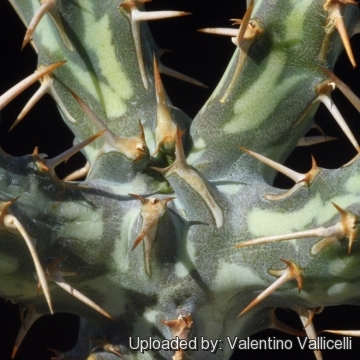 Euphorbia erigavensis Photo by: Valentino Vallicelli
Euphorbia erigavensis Photo by: Valentino Vallicelli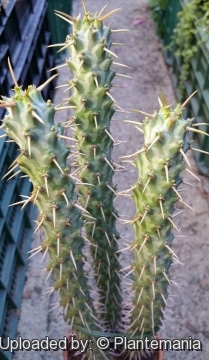 Euphorbia erigavensis Photo by: © Plantemania
Euphorbia erigavensis Photo by: © Plantemania Euphorbia erigavensis Photo by: Valentino Vallicelli
Euphorbia erigavensis Photo by: Valentino Vallicelli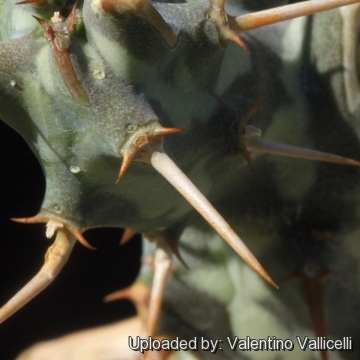 Euphorbia erigavensis Photo by: Valentino Vallicelli
Euphorbia erigavensis Photo by: Valentino Vallicelli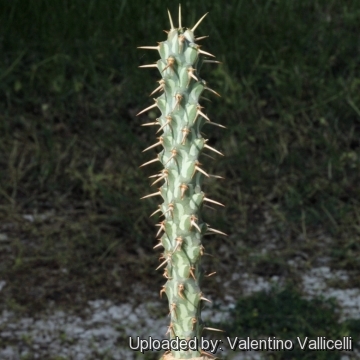 Euphorbia erigavensis Photo by: Valentino Vallicelli
Euphorbia erigavensis Photo by: Valentino VallicelliSend a photo of this plant.The gallery now contains thousands of pictures, however it is possible to do even more. We are, of course, seeking photos of species not yet shown in the gallery but not only that, we are also looking for better pictures than those already present.
Read More... Cultivation and Propagation: This specie has the fame to be quite tricky to cultivate. A very very light and warm place in full sun is highly appreciated. It does best in a mineral soil, good drainage is essential. Water sparingly during the summer months and keep dry in winter. In the short growing season it likes ample water and in this period it grows rather quickly, though not for a long time. When not in growth it is killed right away, when given too much water. It is a slow growing long lived plant and once established, it will be content in its position and with its soil for years. It can tolerate moderate shade, and a plant that has been growing in shade should be slowly hardened off before placing it in full sun as the plant will be severely scorched if moved too suddenly from shade into sun.
Frost Tolerance: Tender, it needs frost protection. Recommended minimum temperature is 12 °C or even above.
Propagation: It is propagated from seed sown during spring or summer. Germination occurs within 3 weeks. Sowing seed of this self fertile species is the surest method of growing typical offspring and seedlings are in the first season relatively easy to grow. It can be reproduced by cuttings or grafting as well but often lateral branches fail to produce the characteristic thick main stem.
Grafting: The plants that are grafted on a more vigorous and easier stocks are easier to keep, grow faster and produce more flowers and seeds. The method of grafting euphorbias differs little from that of other succulents, except in one important aspect. The latex must be washed or sprayed off until hardly anything remains. After the latex flow has stopped, a further 1-2 mm slice can be taken from both surfaces without a new latex flow starting. Both scion and stock need to be at the start of the growing season. The stock should be cut as near as possible to the growing tip, as here the vascular bundles are dense and not yet woody and will feed the scion in the best possible way. Where possible stock and scion should be of similar diameter. The cut surfaces are held together with elastic bands in cross style, over the plant top and under the pot. The plants should be left in an airy and shady place for 7-10 days before the bands are removed.
Warning: As with all other Euphorbias when a plant get damaged it exudes a thick white milky sap known as latex. This latex is poisonous and particularly dangerous for the eyes, skin and mucous membranes. So pay extreme attention not to get any in your eyes or mouth. Cultivated plants must be handled carefully.
















